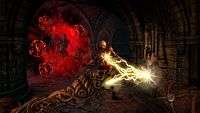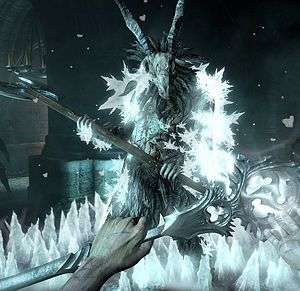Hellraid – Preview
by Chris
|
 There are only three games in the history of video gaming that have got sword fighting ‘right’ in my opinion. Dark Messiah of Might and Magic, Skyrim, and Dishonored all have elements that elevate them above other examples of melee combat within gaming. Might and Magic has speed, and excellent use of environmental influences when fighting, making you feel like some sort of mystical Zorro. Skyrim combines some of the most dangerous heavy weapons and magical spells to create a sense of acting out some blood-thirsty battle-mage fantasy. Finally, Dishonored mimics the art of duelling, parrying, and executing in order to capture the feeling of being a skilled swordsman. After seeing Hellraid, the latest title in development from Techland, I believe we have a strong contender for adding another game to that list.
There are only three games in the history of video gaming that have got sword fighting ‘right’ in my opinion. Dark Messiah of Might and Magic, Skyrim, and Dishonored all have elements that elevate them above other examples of melee combat within gaming. Might and Magic has speed, and excellent use of environmental influences when fighting, making you feel like some sort of mystical Zorro. Skyrim combines some of the most dangerous heavy weapons and magical spells to create a sense of acting out some blood-thirsty battle-mage fantasy. Finally, Dishonored mimics the art of duelling, parrying, and executing in order to capture the feeling of being a skilled swordsman. After seeing Hellraid, the latest title in development from Techland, I believe we have a strong contender for adding another game to that list.
Hellraid is a first-person hack and slash that features brutal and immersive combat in a ruined and decaying landscape. Players taken on the role of a knight, of sorts, who is the last of his order operating under a cursed king. In order to try and restore an imbalance in the world created by a battle between religion and magic, he is forced to cooperate with an untrustworthy mage and embark on a journey that will see him fight all manner of evil beings. If single-player stories don’t interest you, then you can always approach the game cooperatively with two-to-four friends and take part in either story, mission, or arena modes.
On show for us was an extract from the story mode. Players found themselves in a monastery on a mission to meet with an abbot. There was a very heavy emphasis on Gothic architecture right from the start and Techland told us that they have a member of the team that focuses on the aesthetics and influences of the medieval period, in order to correctly capture the setting they are aiming for. It’s certainly obvious that someone is putting a lot of effort into the setting and the graphical authenticity of the environment – the areas we moved through were dank and decaying, but equally quite remarkable.
 Moving through the early stages of the monastery, dozen of weapons were being collected and we were assured that the finished product will have hundreds of thousands of different weapons to choose from, including swords, maces, hammers, axes, staffs and, of course, your trusty right foot. Combat comes in the form of light and heavy attacks, and each weapon will have a different trajectory based on its type and method of attack. The trajectory of the weapon will also affect the damage against the opponent.
Moving through the early stages of the monastery, dozen of weapons were being collected and we were assured that the finished product will have hundreds of thousands of different weapons to choose from, including swords, maces, hammers, axes, staffs and, of course, your trusty right foot. Combat comes in the form of light and heavy attacks, and each weapon will have a different trajectory based on its type and method of attack. The trajectory of the weapon will also affect the damage against the opponent.
It was now that the first enemies appeared – a horde of skeletons brandishing axes of their own. Swinging your weapon at the same time as them causes a parry effect allowing for a quick counter attack, provided nothing else is trying to cave your face in. If players have a shield, they can use it to block incoming attacks and bash opponents. In this instance, a basic sword was used to parry and then give a hefty counterattack, instantly killing the skeleton. With larger weapons, the trajectory of the swing may catch multiple opponents, the only downside being that such a large attack leaves you open to take damage from other sources.
 |
 |
 |
 |
 |
 |
As the player went further into the level, other enemies made themselves known. These were still skeletons, but some were armoured while others wielded crossbows or magical staffs. Once destroyed, the staffs could be used by the player as weapons. The four magic properties currently on offer are fire, lightning, freezing, and curse. Interestingly, each staff is capable of a different action, but they can’t all perform every magical attack.
 For example, a fire staff may have an area-attack function, but that same staff can’t perform a precise single shot, whereas a lightning staff could attack a single person but not a group. Each magical property will have multiple staffs with individual functions, which means you won’t find one staff that works for all your needs. Furthermore, each staff and each type of magic is cast with a different animation, meaning you won’t be watching the same thing over and over every time you want to ditch your halberd.
For example, a fire staff may have an area-attack function, but that same staff can’t perform a precise single shot, whereas a lightning staff could attack a single person but not a group. Each magical property will have multiple staffs with individual functions, which means you won’t find one staff that works for all your needs. Furthermore, each staff and each type of magic is cast with a different animation, meaning you won’t be watching the same thing over and over every time you want to ditch your halberd.
After much skeleton and zombie killing, the end of level boss – Hircus – appeared. He is a large goat-like creature with human features, and carries a massive double-sided axe. Techland state that plenty of their largest enemies have groundings in European folklore and myth, which promises to deliver on some more hideous creatures by the time development on the game is complete. Fighting him looked tricky – a mix of dodging his giant axe, his sprint attacks, and the various minions spawning around him. Employing some environmental assistance was required and cutting away some rope brought a chandelier crashing down on some of the smaller enemies. Hircus still needed dealing with though, and some deft dodging combined with good use of magic meant he was soon beaten.
Moving through some of the smaller corridors of the surprisingly large monastery, we come up against a second boss character – a tall knight with a helmet nailed to his head making him blind. This disgusting horror was quicker than Hircus and more dangerous due to his blind nature, which caused him to swing his weapon around trying to hit the player. Again, distance was key, and some magic combined with heavy attacks of our own meant that the knight was defeated.
 It was now that Hircus reappeared (much to everyone’s surprise) and the player was forced to fight him again. It wasn’t clear if bosses would have to be fought twice or if this was somehow linked to the story, although Techland mentioned that Hircus is one of Satan’s main underlings and a beast that occupies the third circle of hell. They hope to have around fifteen larger demons in the final version.
It was now that Hircus reappeared (much to everyone’s surprise) and the player was forced to fight him again. It wasn’t clear if bosses would have to be fought twice or if this was somehow linked to the story, although Techland mentioned that Hircus is one of Satan’s main underlings and a beast that occupies the third circle of hell. They hope to have around fifteen larger demons in the final version.
The demo drew to a close shortly after this fight and I was left suitably impressed with plenty of questions left unanswered. Why was the king cursed? Who was the player in all of this? Why were we at the monastery and why was it full of monsters? Techland promised that the final game will have plenty of outside areas including swamps and mountains. They went on to say that there is focus on the weaknesses of mankind and how evil monsters prey on those weaknesses.
In closing, Techland mentioned that they are aiming for a 2015 release and that there will be Early Access via Steam in due course. This seemed like a strange decision, but they insisted that it was to check the balancing and replayability, and test the arena and mission modes. Personally, I have no problem with this, provided it isn’t their way of getting Q&A done via the public – there’s a reason why people are paid to do that.
That concern aside, I’m very excited for Hellraid. It looks like a gritty, challenging, and harsher version of Skyrim with an intriguing storyline and a heavy emphasis on combat and player development. Certainly one to be keeping an eye on in 2015.
Last five articles by Chris
























“There are only three games in the history of video gaming that have got sword fighting ‘right’ in my opinion.”
Author pls. Play Dark Souls.
It’s on the list dude. Like every other game released post 2010